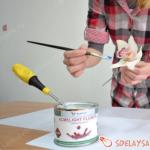Favorable days for transplanting indoor plants: recommendations from professionals
Flower care is best done on certain days. Many indoor plant enthusiasts grow them at random, especially beginner gardeners. And they face the problem of insufficient growth, poor survival after transplants - up to the death of plants.
Meanwhile, most problems are easy to avoid if you approach the matter correctly. You can get all the information you need about the technology of transplanting indoor plants in the calendar for gardeners. It indicates the time favorable for activities such as watering, fertilizing and changing the soil. The flowers transplanted these days take root easily and grow actively.
Receptions of the correct transplant
A potted flower transplant is required when the leaves wither, the soil becomes raised, and flowering disappears. More often than not, the soil needs to be replaced. A new pot should be taken about 4 cm larger than the previous one.
To remove the flower, gently moisten the soil and carefully remove the plant along with the soil. At the bottom of the new pot, lay out the drainage with a layer of about 1 cm. If the container is large, the layer thickness can reach up to 5 cm. The earth is poured from above in the form of a mound and the plant is strengthened.
About the most favorable days for transplanting indoor plants
It is impossible to place a flower in the sun, as well as fertilize immediately after the procedure. Transplantation should be done in the absence of flowering, taking into account a certain time of the year. The most suitable periods for this procedure are March-April and September-October. It should not be forgotten that any of the plants has individual characteristics, can bloom and grow actively at completely different times.
The best time to change soil is when the sap is moving towards the stem and leaves. Plants with reduced elasticity of the root system take root in the new soil. When transplanted, they are less prone to breakdowns and other negative effects.

We determine the optimal timing
It is recommended to change the flower soil in the growing phase of the moon. You can determine it by looking at a special lunar calendar. Experts recommend changing the soil at specific periods. These are the spring months - March and May, the summer months - July and August, the whole autumn without restrictions (on favorable days), from the winter months - December.
These tips are based on years of research. It is believed that on the dates mentioned, the change of habitat occurs less painfully, negative impacts are little perceived by plants.
What is the lunar calendar for transplanting indoor plants
It is compiled by specialist researchers in order to simplify the task of caring for representatives of the plant kingdom. The lunar calendar contains information on loosening, watering and other care. There are detailed descriptions of the days when the habitat of the flower should not be changed.
Compose it according to the lunar phases. If you follow the above recommendations, transplanting indoor plants according to the lunar calendar, your flower will not have problems getting used to the new pot. It will actively grow. There are also days in the calendar when any manipulations with plants are highly discouraged. The risk of damage during transplantation for a flower is quite high, and in order to avoid it, you should listen to the advice of specialists.
Below we provide a lunar calendar for indoor plants and flowers for 2017.

Moon phases and our flowers
The state of the moon is considered a major factor influencing the process of growing flowers. The stem actively elongates and feeds on sap in the growth phase. When the celestial satellite is in the full moon phase, changing the habitat of the flower should be avoided. This is because the root system is currently actively feeding.
On the days of lunar eclipses, nature provides moments of rest and accumulation of strength. All living things are slowly reborn, and therefore work with the earth during this period is not recommended. It is on such data that astrologers rely when compiling a lunar calendar for transplanting indoor plants.
About the signs of the zodiac
When caring for plants, it is recommended to take into account which of the zodiac signs the moon is in at one time or another. Favorable signs include Scorpio, Taurus, Cancer, Libra, Capricorn and Pisces. When the moon is "visiting" Leo or Aquarius, work with the earth is not recommended. All other signs, according to astrologers, do not have an active influence on flowers.
All of the above is quite understandable from a scientific point of view. After all, the position of the moon affects the state of the water, sea tides and tides. The nature of our entire planet, together with the process of vegetation growth, depends to a large extent on the lunar phases.

How does this happen
Those dates of the lunar calendar that are indicated as favorable days for transplanting indoor plants coincide with the period when the juice moves to the stem and leaves, that is, to the top of the flower. At the same time, the root system experiences a decrease in turgor, a slight dehydration of the cells, as a result of which they become less brittle. That is why transplantation under these conditions is tolerated as easily as possible, as is the process of taking root in new soil. Then you can successfully propagate flowers by cuttings, using the most favorable days for transplanting indoor flowers.
What is described above coincides with the growth phase of the moon. When it decreases, the opposite happens - the roots are filled with moisture. At this time, they should not be disturbed. Thus, a flowering and healthy appearance of the indoor garden is much easier to achieve by referring to the recommendations of the lunar calendar.
In an emergency
We do not consider cases where an emergency transplant procedure may be required. Pests can suddenly appear, pots sometimes break, and stems break. If it is necessary to urgently save a flower, of course, they no longer pay attention to the schedule. A similar procedure is recommended outside the plan and in case of crushing and yellowing of the leaves, a long absence of flowering.
If the plant has bloomed, it is undesirable to transplant it even on one of the favorable days for transplanting indoor flowers. It is very likely that the green pet will get sick for a long time as a result, and it will be very difficult to cure it.

What to do at other times
There are also unfavorable days for transplanting and planting plants, as well as relatively neutral ones. This time can be filled with procedures of a less radical nature. We are talking about top dressing, loosening, watering, processing from pests. But on those dates that are indicated on the calendar as completely unfavorable, it is better to leave the flowers completely alone. No type of care at this time will benefit the plant.
The most unsuitable days for a transplant are those when lunar and solar eclipses (including partial ones) are observed. The vulnerability of flowers at this time is increased, and even the most minor injury can destroy the plant.
Why do you need a regular transplant
There may be several reasons for this:
1. Overgrown roots no longer fit in the usual container. The earth begins to rise, making it difficult to water.
2. Due to hard water, salts accumulate in the soil, making it difficult for the flower to feed.
3. The soil is depleted, its organic component decomposes. As a result, feeding does not give the desired effect.
4. Due to soil compaction, oxygen starvation of the roots occurs.

The function of indoor plants is not only decorative. They are able to significantly improve the microclimate of the living space by humidifying and conditioning the air, as well as neutralizing the positively charged ions emitted by household appliances. Many types of flowers save the owners from harmful emissions of finishing and furniture materials by absorbing toxins.
Even in the absence of strict adherence to the requirements of the lunar calendar, the plant will tolerate transplanting better when they are done in the spring, during the warm season. It was then that a permanent place of residence for rooted cuttings was determined. If, for some reason, you decide to have an "operation" in the fall, the care in observing favorable days for transplanting indoor plants is even more important.
Using this approach, you will accelerate the growth of your favorite variety and get a lot of little "babies". Self-compilation of the lunar calendar is a rather difficult task. Ordinary amateur flower growers, as a rule, cannot do it. Indeed, professional astrologers take into account a large number of different factors in their work: from the lunar day and month to the position of the sun and moon in certain signs of the zodiac.

Flowers in spring and winter
All work with houseplants is resumed, as a rule, in April - due to warming and an increase in the length of daylight hours. In the last spring month, juices actively circulate in the flowers, metabolic processes (respiration, photosynthesis) are accelerated, greenery begins to grow intensively. Such days are good for rejuvenating overgrown bushes and moving to a new place.
Winter transplanting is not recommended. This is due to the fact that in the cold season a calm period sets in and any process in the living organism of a flower tends to slow down. In order to avoid harm, flower growers try not to touch the plants in winter.
By following these simple recommendations regarding favorable days for transplanting indoor plants and carefully adhering to the lunar calendar, you can surround your green pets with real love and care. And then your efforts will pay off handsomely!




